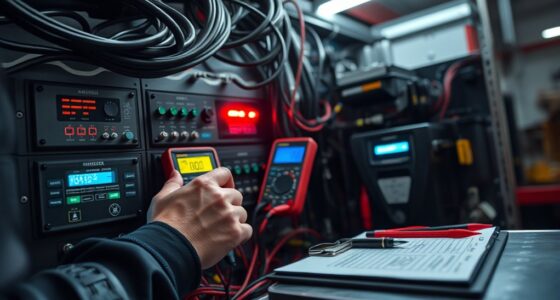Effective record keeping and maintenance logs help you track your equipment’s performance, schedule timely repairs, and prevent breakdowns. Using digital logs streamlines data management, automates reminders, and keeps everyone in the loop. Clear documentation also supports compliance and quicker troubleshooting. Staying organized ensures your equipment runs smoothly and efficiently. Keep exploring to discover ways to optimize your maintenance process and keep your operations running seamlessly.
Key Takeaways
- Accurate recordkeeping ensures equipment functions efficiently and facilitates quick access to maintenance history.
- Digital logs improve data accuracy, streamline storage, and enable easy retrieval of maintenance records.
- Automated reminders and alerts help schedule timely maintenance, reducing equipment failure risks.
- Shared digital logs promote team accountability, clear responsibilities, and task tracking.
- Proper documentation supports compliance, audits, warranty claims, and identification of recurring issues.

Keeping accurate records and detailed maintenance logs is essential for ensuring your equipment operates efficiently and stays in good condition. When you utilize digital recordkeeping, you streamline the entire process, making it easier to store, access, and analyze your maintenance data. Digital systems eliminate the clutter and confusion that often come with paper logs, allowing you to quickly find information about past repairs, service dates, and parts replaced. This ease of access helps you make informed decisions about future maintenance needs and keeps your operations running smoothly. Incorporating smart IoT technologies into your recordkeeping can further automate data collection and enhance overall accuracy.
Digital recordkeeping simplifies maintenance tracking and improves decision-making for efficient equipment operation.
Implementing digital recordkeeping also enhances your maintenance scheduling. With automated reminders and alerts, you can set up alerts for upcoming service intervals, ensuring that maintenance tasks are completed on time. This proactive approach reduces the risk of equipment breakdowns caused by missed or delayed maintenance. By keeping detailed logs of all maintenance activities, you can track patterns over time, identify recurring issues, and plan preventive measures more effectively. This not only extends the lifespan of your equipment but also helps you allocate resources more efficiently.
When you maintain extensive logs, you also improve accountability within your team. Everyone involved in equipment care can access the same up-to-date information, reducing miscommunication and ensuring that maintenance tasks are completed according to plan. Digital recordkeeping makes it easy to assign responsibilities, monitor progress, and verify that all scheduled maintenance has been carried out properly. This consistency is key to maintaining ideal equipment performance and avoiding costly repairs caused by neglect or oversight.
Moreover, detailed maintenance logs serve as valuable documentation during audits, warranty claims, or troubleshooting. If an issue arises, you can quickly review the history of repairs and services performed, which helps identify potential causes and solutions more efficiently. Having accurate, organized records also supports compliance with safety and industry regulations, demonstrating that you’re committed to proper maintenance practices.
Frequently Asked Questions
How Long Should Maintenance Records Be Retained?
You should retain maintenance records according to your organization’s record retention policies, typically for at least 3 to 5 years. Keeping detailed records helps you track your maintenance schedule and guarantees compliance with regulations. Regularly review and update these policies to match industry standards. By staying consistent, you can easily provide proof of maintenance and ensure equipment safety and reliability over time.
What Digital Tools Are Recommended for Record Keeping?
You should use digital storage and cloud solutions like Google Drive, Dropbox, or specialized maintenance management software to keep your records organized and accessible. These tools allow you to securely store, update, and share maintenance logs from anywhere. Cloud solutions also provide automatic backups, reducing the risk of data loss. By choosing reliable digital tools, you guarantee your records stay current, easy to retrieve, and compliant with retention policies.
How to Ensure Confidentiality of Maintenance Logs?
Imagine your maintenance logs as a treasure chest, guarded fiercely. To keep their contents private, you implement confidentiality protocols, ensuring only authorized personnel can access them. Use access control measures like passwords, user roles, and encryption to lock down sensitive information. Regularly review and update these protocols to stay ahead of potential breaches. By doing so, you protect your data’s integrity and maintain trust in your record-keeping system.
Who Should Have Access to Maintenance Records?
You should restrict access to maintenance records to authorized personnel only, such as maintenance managers and relevant staff. Implement access restrictions to protect sensitive information and ensure accountability. Use audit trails to monitor who views or modifies the records, helping you detect any unauthorized access. By controlling access and maintaining detailed logs, you safeguard confidentiality, guarantee data integrity, and comply with organizational policies and regulations.
How to Handle Incomplete or Missing Maintenance Logs?
Think of incomplete logs like a puzzle missing pieces—you need the full picture. To handle missing documentation, review your logs for gaps, then follow up with technicians or staff to fill in the blanks. If logs are incomplete, prioritize updating them promptly to ensure log completeness. Establish clear procedures for documenting maintenance activities and regularly audit records, so missing documentation doesn’t become a blind spot in your maintenance history.
Conclusion
By keeping detailed records and maintenance logs, you create a sturdy foundation that supports your operations like an unshakable fortress. These logs act as your guiding lighthouse, illuminating past actions and guiding future decisions. Remember, neglecting proper documentation can leave you adrift in a storm of confusion. So, embrace diligent record-keeping—it’s the key that discloses smooth, successful management and keeps your systems running like a well-oiled machine.









